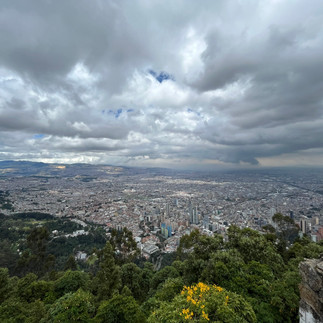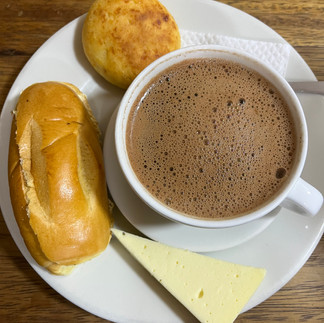4 Reasons Why Colombia Beckons Solo Travellers
- hptraveldiaries

- May 20, 2024
- 7 min read
Colombia is a country with a thriving cultural scene, diverse landscapes, distinctive cuisine, and friendly people. Despite lingering negative portrayals in various media, the country is a gem waiting to be discovered. However, you must equip yourself with in-depth research, of where to go and where to avoid as a tourist, and visit with an open mind, especially if you're intending to go solo.

It’s a country which encompasses all the things people may travel for - cityscapes, coastal tranquillity, majestic mountainous regions, and jungle escapades - making it an ideal destination to explore on your own, or with a group tour. Not to mention, it's also a hotspot for wellness retreats or experiences - for example, I highly recommend experiencing a Cacao ceremony (I took part in one at Flying Tree Yoga in Medellín).

I fell in love with the appetising street food - from arepas to lechona, dancing in salsa bars, the music everywhere, local drinks like aguapanela (sugar cane) and aguardiente (liqueur), the adventurous activities on offer, breathtaking scenery, and the list goes on! Since returning, I haven't stopped talking about my adventures there.
Here are four reasons why I think it's a destination that attracts more and more solo travellers:
Good infrastructure for tourists
Domestic flights are an efficient and cheap-ish way of travelling around the country, specifically if you want to cover long distances quickly. Some of the major airlines include Avianca and LATAM.
Buses are an even more affordable transport option, and the network is extensive. Bus companies like Bolivariano, Rapido Ochoa, and Expreso Brasilia connect major cities and towns, and they can be booked online via redbus. The only thing I'd note with buses is that you should expect delays. For example, going from Salento to Jardín, was only meant to take 3 hours - but it ended up taking 10! As a solo traveller, I'd recommend avoiding travelling on buses at night, especially on less-travelled routes.
Ride sharing is a big thing in Colombia - known as Collectivos. These are a great way to get from some airports into the centre of a city. If you don't feel comfortable doing this, then I'd suggest using apps like Uber, DiDi, and Cabify to order taxis. I'd avoid getting in the local yellow cabs where possible, as I've heard that some tourists have been robbed.
2. The backpacker scene is big
Colombia has an up-to-date hostel scene, thriving with backpackers, solo and not. By the coast, you can find surf camps and eco-stays, whereas in the main bustling cities you can find modern - or tech-savvy bases - to host the number of digital nomads. In the jungle, you can stay in a hammock, or there is even the opportunity to experience a couple nights in a floating home (Casa en el Agua) in the Caribbean Sea.
Hostels are a great option if you're travelling solo, as they're not only a place to sleep, but they also offer a plethora of activities and events, from walking tours to salsa lessons. They are a great way to stay safe, meet other travellers, and be introduced to Colombian culture at the same time.
Some popular hostel chains in Colombia are Masaya, Selina, and Dreamer Hostel.
I'd recommend choosing centrally located hostels in safe neighbourhoods. For example, in Medellín, many tourists stay in Manila/El Poblado.
It's also possible to stay in ecolodges and homestays, but make sure to check the reviews before booking, and book on reliable websites, like booking.com. There are also many worldpackers experiences available in Colombia - where you can stay in accommodation for free and do work exchanges (a great solo travel idea) - check them out here.
Places I stayed, by city:
Medellín - Los Patios hostel
Cartagena - Viajero hostel & Zion Beach House (but I do not recommend Zion for solo female travellers)
Jardin - Gulupa Ecolodge
Filandia - Bidea Backpackers hostel
Salento - Hotel Salento Real Eje Cafetero
Bogota - Cranky Croc hostel
3. Diverse landscapes to explore
Colombia is home to a variety of landscapes, making it a dream destination for nature lovers and adventure seekers. There's an array of environments to discover, for every type of traveller: from the eco-tourism activities in the Amazon rainforest to the high-altitude hikes in the Andes Mountains.
In the coffee region, you can see the tallest palm trees in the world, ride around in jeeps, and witness the coffee-making process from bean to cup. Visit Secretos Del Carriel in Quimbaya - put on traditional farm attire, and learn from a local how to make your own coffee from scratch (you can even stay on the farm). Or, explore the charming village of Filandia, which has a similar architectural style to Salento, but is slightly more quaint.
Salento is overflowing with tourists, souvenir shops, hotels, and touristy restaurants. Filandia hasn’t quite reached this stage yet, so it's still a hidden gem really. It’s home to the best restaurant in Quindio - Helena Adentro (but make sure to book a table in advance as it gets booked up). There are tons of small family-run coffee shops you can visit not too far from here, and it's a village that will expose you to the local and traditional way of life. It features colourfully-painted colonial buildings, and the ideal spot for people-watching - Plaza Bolivar - the main square in town.
There are a range of activities in Cartagena, and nearby areas, from relaxing on pristine beaches - to snorkelling in the coral reefs. Solo-travellers can go on organised nights out with their hostels in the bustling coastal town of Cartagena, partake in a free historical walking tour of the UNESCO World Heritage Site, or even indulge in some shopping.
4. Rich cultural heritage
The country has a rich cultural tapestry. Take Medellín, a city known for its transformation in recent years, specifically Comuna 13, which used to be one of the most dangerous neighbourhoods in the city. Here you can find urban projects and cultural festivals, as well as local art displays (from dance to graffiti).
Check out Zippytours for a free tour of Comuna 13 (based on tips).

After spending 2 weeks exploring the city, I realised it's a very special place. It has risen from its past, and is now one of the friendliest - and most innovative cities in Colombia.
One thing that enhanced my experience of Medellín was also watching a football match. This is not something I recommend doing alone, as it can get super crowded and dangerous. However, many hostels offer this as a group tour. Or, you can do what I did - befriend some other travellers and go to the game together!
Guatapé is an ideal day trip from Medellín, so make sure to include this in your itinerary. It's very safe, and is the perfect escape from the city. Discover the colours of the town, from the art galleries to the famous rainbow street, and climb the well-known rock Piedra del Penol. I did Los Patios' tour to Guatapé, and it did not disappoint. We were given the opportunity to taste distinct local fruits, try traditional Colombian snacks like cheese bread, and even visit a local family's home and have a meal there. Then, we explored a tiny remote island in the lake by boat. Here, we saw first-hand the unique biodiversity, like a plant that looked like human lips.

You can discover the strong artisan community in Filandia, Quindio, where the most popular craft is weaving. Woven baskets is a trade that has passed down through generations, so it’s a great opportunity to learn about the historical nature of the traditional Colombian village. If you wander the streets, you are sure to find a basket-making workshop, especially if you walk down Carrera 4 towards the mirador (viewpoint).
In Bogotá, you can visit various museums, like the "Museo Del Oro" (gold museum), which is home to over 34,000 gold items, and on Sundays it's free entry! I did a free walking tour with my hostel (Cranky Croc), and we visited Cafe del Mercado, for a quality coffee-tasting experience. Take a walk through La Candelaria, the historical district of Bogota, and learn about the history behind the colonial houses and streets, or enjoy the local cafes and shops. As it's the capital city of Colombia, it's a great place to try traditional plates like Bandeja Paisa, Chocolate Completo, Ajiaco, Sancocho de Pollo, and more. Don't miss out on great markets, too, for example, Plaza La Concordia, where you can try Chicha, an indigenous beverage. But, I will say this is the city where I felt most unsafe as a solo female traveller.
If visiting the Caribbean coast, there are various island boat tours, which include snorkelling, visiting the 5 main islands, and having a proper Caribbean meal. I booked my tour via Viajero hostel, and it was a full-day island hopping tour. There was a guided walk around Tierra Bomba, which is the island that established the gateway to Cartagena Bay in colonial times.
There are so many other cultural wonders in Colombia, from salsa dancing in the bars of Cali to visiting Barranquilla in February when the country's biggest carnival parades the streets. Unfortunately, I couldn't do everything in the month I was there, but I cannot wait to go back and explore more of the beautifully diverse and culturally rich country.
PRE-TRIP ADVICE
Research where you're going and pick the right destinations. There's so much to see so make sure you have a basic itinerary to follow (but save room for last-minute plans)
Safety tips: stay up to date with travel advisories, ask others who have travelled there recently what their advice is, bring a money belt/anti-theft bag (handy for exploring some parts of the major cities)
Make sure you have travel insurance so you are covered in case of health, accidents, theft and cancellations
Learn some basic Spanish - this can enhance your experience of the country, help you connect better with locals and also may help you in certain emergencies
Vaccinations - ensure your standard vaccines are up to date, Yellow Fever is a requirement for certain regions e.g. Santa Marta
BEST TIME TO VISIT
Being close to the equator and due to altitude, temperatures vary. Also, coastal regions are warmer and more humid, while places like Bogotá are cooler. Medellín is called the city of eternal spring for a reason.
The most popular time to visit Colombia is during the dry season, from December to March, but this is also when the prices rise as many Colombians also decide to holiday at this time of year. There are a number of local and national fiestas around these times, too. I travelled in June/July time and it was quite busy with tourists, but maybe not as busy as the peak season, which had its advantages.
FINAL TIPS
Remain alert to scams targeting tourists
"No dar papaya" means don't put yourself in a position where people can take advantage of you (ie don't show off flashy gadgets, or jewellery, don’t walk around at night by yourself etc.)
With vendors, try and refuse anything that's "free" - as most likely it's not - this is specifically something to be aware of if using buses to get around
Petty theft occurs, so sometimes it's best to leave valuable items at your hostel/hotel

























































Comments